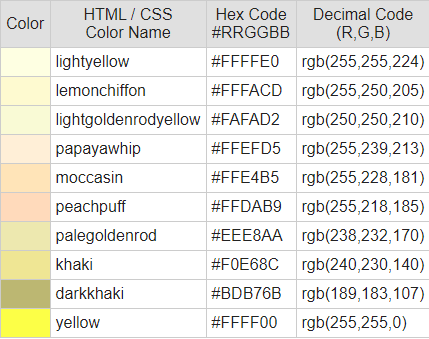
How can you do that? Just keep adding a little bit at a time to the green amount until it gets all the way up to FF, and then start taking a little bit away from the red amount until it gets down to 00.Īnd how much is "a little bit"? However much you think it takes to get a smooth transition. So your goal is to get from FF 00 00 (red only, no green or blue) to FF FF 00 (red mixed with green, which is yellow), and finally to 00 FF 00. They have six digits, where the first two show the amount of red in the color, the middle two show the amount of green, and the last two show the amount of blue.Īnd unlike human counting where when we get from 0 to 9 we move to the next place value and get 10, with hexidecimal we count all the way up to F. See, the cryptic hexidecimal codes are actually not at all cryptic. In fact, the smoothest transition you can get is to simply increment the amount of green in the color and decrement the amount of red. Looking at any chart will give the illusion that "color codes" are individual values that you must lookup. Return (hex.length < 2) ? "0" + hex : hex * digit hex codes with 0 to always return a two digit code. * Converts integer to a hexidecimal code, prepad's single The solution (in Javascript) I worked out looked like this: /** However, I found that, visually, the changes seemed to be much more drastic around "yellow," while they were barely noticeable around "red" and "green." I found that I could compensate for this by making the changes exponential rather than linear, causing the increments to be smaller around "yellow" and larger around "red" and "green".

That is, smoothly incrementing from red (FF0000) to (FFFF00) to (00FF00). I just had a project and began with more or less similar solution to jball and Asaph. Below is an example going in steps of 11 hex ( 17 in decimal): FF0000 <- red So now how does one make a gradient transitioning from red to yellow to green? Easy you take the end points, decide how many steps you want in between, and then evenly step through each of the 3 color channels to transition from one color to the next color. If you convert the hex numbers to decimal, you'll get a value in between 0 and 255. Similarly, pure green is 00FF00 and pure blue is 0000FF. FF0000 looks red because the red component is dialed all the way up to FF and the green and blue are dialed all the way down to 00. So for example in the color FF0000, the red component is FF, the green component is 00 and the blue component is 00. The hex color codes are triplets representing the red, green and blue components of the color respectively.
#Css color codes yellow how to
Once you grasp this, it will become clear how to make gradients of arbitrary smoothness. a color number, such as "#FF0000", "#FFFFFF" (those are red and white).The best way to do this is to understand what the hex color codes actually mean. HTML used to recognize 16 color names ("black", "white", "gray", "silver", "maroon", "red", "purple", "fushsia", "green", "lime", "olive", "yellow", "navy", "blue", "teal", and "aqua"), but new browsers can recognize 147 CSS3 color names. Simply add a style attribute to the text element you want to color – a paragraph in the example below – and use the color property with your Hex code.
#Css color codes yellow code
Text color using Hex color codes The most common way of coloring HTML text is by using hexadecimal color codes (Hex code for short).

One may also ask, how do you use HTML color codes? If you notice the yellow is too bright before you paint, add red to the mix. Red is a complementary color to green and will work to make the bright green and yellow mixture appear warmer and more subdued. Adjust the yellow by adding a bit of red paint. Whereas in a CMYK color space, it is composed of 0% cyan, 0% magenta, 100% yellow and 0% black.įurthermore, how do you make light yellow? Bright yellow is often created by mixing in bright green. In a RGB color space, hex #ffff00 (also known as Yellow, Electric yellow) is composed of 100% red, 100% green and 0% blue.


 0 kommentar(er)
0 kommentar(er)
